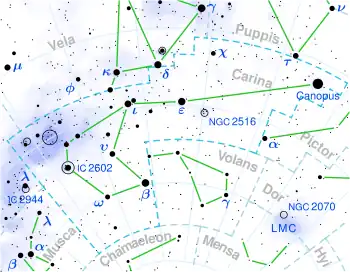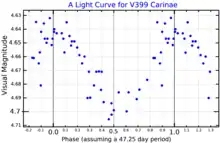V399 Carinae
V399 Carinae (V399 Car, P Carinae, P Car, 195 G. Carinae) is a variable star in the constellation Carina.
 | |
| Observation data Epoch J2000.0 Equinox J2000.0 | |
|---|---|
| Constellation | Carina |
| Right ascension | 10h 27m 24.47049s[1] |
| Declination | −57° 38′ 19.6984″[1] |
| Apparent magnitude (V) | +4.63 to +4.72[2] |
| Characteristics | |
| Spectral type | A5Iae[3] or F0Ia[4] |
| U−B color index | +0.22[5] |
| B−V color index | +0.46[5] |
| Variable type | SRd?[2] |
| Astrometry | |
| Proper motion (μ) | RA: −7.377[1] mas/yr Dec.: +3.688[1] mas/yr |
| Parallax (π) | 0.4976 ± 0.1151 mas[1] |
| Distance | approx. 7,000 ly (approx. 2,000 pc) |
| Absolute magnitude (MV) | −8.8[6] |
| Details | |
| Mass | 22.6[7] M☉ |
| Radius | 171[8] R☉ |
| Luminosity | 73,000[9] L☉ |
| Surface gravity (log g) | 1.00[10] cgs |
| Temperature | 8,000[11] K |
| Metallicity [Fe/H] | −0.06[10] dex |
| Age | 12[12] Myr |
| Other designations | |
| Database references | |
| SIMBAD | data |
The spectral type of V399 Carinae has been variously assigned between A5 and F0,[15] being a bright, luminous supergiant.[16] Its spectrum is described as having a non-photospheric continuum and silicon absorption lines, indicative of high mass loss.[17]

V399 Carinae has long been suspected to be variable.[18] A 1981 study of yellow supergiants fit observations to a Cepheid-like light curve with a period of 58.8 days, although the luminosity and spectral type do not place the star near the Cepheid instability strip.[15] It was listed in the General Catalogue of Variable Stars as a possible δ Cep variable.[19] Further observations refined the period to 47.25 days.[6] The Hipparcos catalogue classified V399 Car as a semiregular variable with a period of 88 days and a mean amplitude of only 0.04 magnitudes.[20] An automated classification from Hipparos photometry suggested it is an α Cygni variable.[21] The observed brightness varies from magnitude +4.63 to +4.72.[2]
V399 Carinae lies amongst the stars of the open cluster IC 2581, by far the brightest member of the cluster. It is about 7,500 light years from Earth assuming it is a member of IC 2581, which is given a 62.9% probability.[22]
References
- Vallenari, A.; et al. (Gaia collaboration) (2023). "Gaia Data Release 3. Summary of the content and survey properties". Astronomy and Astrophysics. 674: A1. arXiv:2208.00211. Bibcode:2023A&A...674A...1G. doi:10.1051/0004-6361/202243940. S2CID 244398875. Gaia DR3 record for this source at VizieR.
- Watson, C. L. (2006). "The International Variable Star Index (VSX)". The Society for Astronomical Sciences 25th Annual Symposium on Telescope Science. Held May 23–25. 25: 47. Bibcode:2006SASS...25...47W.
- Gray, R. O.; Garrison, R. F. (1989). "The late A-type stars - Refined MK classification, confrontation with Stromgren photometry, and the effects of rotation". Astrophysical Journal Supplement Series. 70: 623. Bibcode:1989ApJS...70..623G. doi:10.1086/191349.
- Dambis, A. K. (February 2013). "Revisiting the absolute-magnitude calibration of F-type supergiants and bright giants as a function of the equivalent width of the OIλ7774Å triplet". Advancing the Physics of Cosmic Distances, Proceedings of the International Astronomical Union, IAU Symposium. 289: 379−381. Bibcode:2013IAUS..289..379D. doi:10.1017/S1743921312021758.
- Schild, R. E.; Garrison, R. F.; Hiltner, W. A. (1983). "UBV photometry for southern OB stars". Astrophysical Journal Supplement Series. 51: 321. Bibcode:1983ApJS...51..321S. doi:10.1086/190852.
- Berdnikov, L. N.; Turner, D. G. (1997). "Photoelectric VIc and New Elements for V399 Carinae = HR 4110". Information Bulletin on Variable Stars. 4456: 1. Bibcode:1997IBVS.4456....1B.
- Kervella, Pierre; Arenou, Frédéric; Thévenin, Frédéric (2022). "Stellar and substellar companions from Gaia EDR3". Astronomy & Astrophysics. 657: A7. arXiv:2109.10912. Bibcode:2022A&A...657A...7K. doi:10.1051/0004-6361/202142146. eISSN 1432-0746. ISSN 0004-6361.
- Stassun, Keivan G.; et al. (9 September 2019). "The Revised TESS Input Catalog and Candidate Target List". The Astronomical Journal. 158 (4): 138. arXiv:1905.10694. Bibcode:2019AJ....158..138S. doi:10.3847/1538-3881/ab3467. ISSN 0004-6256.
- Anderson, E.; Francis, Ch. (2012). "XHIP: An extended hipparcos compilation". Astronomy Letters. 38 (5): 331. arXiv:1108.4971. Bibcode:2012AstL...38..331A. doi:10.1134/S1063773712050015. S2CID 119257644.
- Luck, R. Earle (2014). "Parameters and Abundances in Luminous Stars". The Astronomical Journal. 147 (6): 137. Bibcode:2014AJ....147..137L. doi:10.1088/0004-6256/147/6/137.
- Rest, A.; Prieto, J. L.; Walborn, N. R.; Smith, N.; Bianco, F. B.; Chornock, R.; Welch, D. L.; Howell, D. A.; Huber, M. E.; Foley, R. J.; Fong, W.; Sinnott, B.; Bond, H. E.; Smith, R. C.; Toledo, I.; Minniti, D.; Mandel, K. (2012). "Light echoes reveal an unexpectedly cool η Carinae during its nineteenth-century Great Eruption". Nature. 482 (7385): 375–8. arXiv:1112.2210. Bibcode:2012Natur.482..375R. doi:10.1038/nature10775. PMID 22337057. S2CID 205227548.
- Luck, R. Earle (1994). "Open cluster chemical composition. 1: Later type stars in eight clusters". Astrophysical Journal Supplement Series. 91: 309. Bibcode:1994ApJS...91..309L. doi:10.1086/191940.
- Kostjuk, N. D. (2004). "VizieR Online Data Catalog: HD-DM-GC-HR-HIP-Bayer-Flamsteed Cross Index (Kostjuk, 2002)". VizieR On-line Data Catalog: IV/27A. Originally Published in: Institute of Astronomy of Russian Academy of Sciences (2002). 4027. Bibcode:2004yCat.4027....0K.
- Benjamin Apthorp Gould (1879). Uranometria Argentina: Brightness and Position of Every Fixed Star, Down to the Seventh Magnitude, Within One Hundred Degrees of the South Pole. Coni. pp. 159–.
- Arellano Ferro, A. (1981). "A survey of variable yellow supergiants in the southern Milky Way". Astronomical Society of the Pacific. 93: 351. Bibcode:1981PASP...93..351A. doi:10.1086/130837. S2CID 250812474.
- Evans, L.; Francis, Ch. (1969). "The open cluster IC 2581". Monthly Notices of the Royal Astronomical Society. 146 (5): 101. Bibcode:1969MNRAS.146..101L. doi:10.1093/mnras/146.2.101.
- Ardila, David R.; Van Dyk, Schuyler D.; Makowiecki, Wojciech; Stauffer, John; Song, Inseok; Rho, Jeonghee; Fajardo-Acosta, Sergio; Hoard, D. W.; Wachter, Stefanie (2010). "The Spitzer Atlas of Stellar Spectra (SASS)". The Astrophysical Journal Supplement. 191 (2): 301. Bibcode:2010ApJS..191..301A. doi:10.1088/0067-0049/191/2/301. S2CID 22689941.
- Arp, H. C. (1958). "Southern hemisphere photometry II Photoelectric measures of bright stars". Astronomical Journal. 63: 118. Bibcode:1958AJ.....63..118A. doi:10.1086/107703.
- Kholopov, P. N.; Samus, N. N.; Kazarovets, E. V.; Perova, N. B. (1985). "The 67th Name-List of Variable Stars". Information Bulletin on Variable Stars. 2681: 1. Bibcode:1985IBVS.2681....1K.
- Perryman, M. A. C.; Lindegren, L.; Kovalevsky, J.; Hoeg, E.; Bastian, U.; Bernacca, P. L.; Crézé, M.; Donati, F.; Grenon, M.; Grewing, M.; Van Leeuwen, F.; Van Der Marel, H.; Mignard, F.; Murray, C. A.; Le Poole, R. S.; Schrijver, H.; Turon, C.; Arenou, F.; Froeschlé, M.; Petersen, C. S. (1997). "The HIPPARCOS Catalogue". Astronomy and Astrophysics. 323: L49. Bibcode:1997A&A...323L..49P.
- Dubath, P.; Rimoldini, L.; Süveges, M.; Blomme, J.; López, M.; Sarro, L. M.; De Ridder, J.; Cuypers, J.; Guy, L.; Lecoeur, I.; Nienartowicz, K.; Jan, A.; Beck, M.; Mowlavi, N.; De Cat, P.; Lebzelter, T.; Eyer, L. (2011). "Random forest automated supervised classification of Hipparcos periodic variable stars". Monthly Notices of the Royal Astronomical Society. 414 (3): 2602. arXiv:1101.2406. Bibcode:2011MNRAS.414.2602D. doi:10.1111/j.1365-2966.2011.18575.x. S2CID 118560311.
- Baumgardt, H.; Detbarn, C.; Wielen, R. (2000). "Absolute proper motions of open clusters. I. Observational data". Astronomy and Astrophysics Supplement. 146 (2): 251. arXiv:astro-ph/0010306. Bibcode:2000A&AS..146..251B. doi:10.1051/aas:2000362. S2CID 7180188.